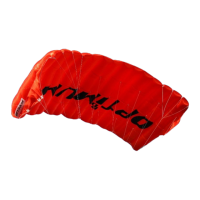MAN-0012 Rev. I Page | 11
SECTION 3
DEPLOYMENT BODY POSITION AND AIRSPEED
Although it is not always possible in emergency situations, it is desirable to have a good body
position for deployment of any parachute canopy. It is usually best to be belly to earth with a
good arch and head high with shoulders level on deployment. Other body positions may increase
the possibility of parachute damage, malfunction, high opening shocks, or excessively slow
deployments. However, while good body position is desirable, it is unwise to waste altitude to get
into a good body position. To reduce the risk of serious injury or death, proper training in how to
control your body position during deployment is required.
Deploying your reserve with one shoulder low may increase the possibility of line twists. It may
take considerable time and altitude to untwist the lines, particularly at high wing loadings with
the associated high descent rate.
DEPLOYMENT SPEED
It is important to understand the deployment speed limitations of your parachutes and stay within
their placarded limits. Failure to do so may result in failure of the parachute, serious injury or
death. Your deployment speed is affected by three factors:
• Basic body position and body type
• Deployment altitude
• Temperature during deployment
HIGH FREEFALL SPEEDS
Some body positions such as head down, stand up and long dives, may enable the user to reach
speeds and attitudes beyond those for which your equipment has been designed and tested.
Premature or unintentional deployments in these body positions, even if you are below the
maximum placarded deployment speed, are extremely dangerous.
Your parachute system was designed to operate within specific weight and speed parameters,
while oriented in a body position ranging from “belly to earth” to a slightly “head high” attitude.
Deployments outside of these limits could cause any/all of the following:
•
Extremely hard openings resulting in equipment failure
•
Severe bodily injury
•
Possible harness failure or ejection from the harness
•
Canopy damage, malfunction or death
Do not exceed the operational speed or weight limits of your parachute system. You should avoid
deploying in an attitude that your equipment was not designed for. The maximum operating
limitations of your system are the lowest weight limit and lowest airspeed limit of any of the
system components. You need to check the reserve parachute, main parachute and
harness/container to determine the operating limitations.

